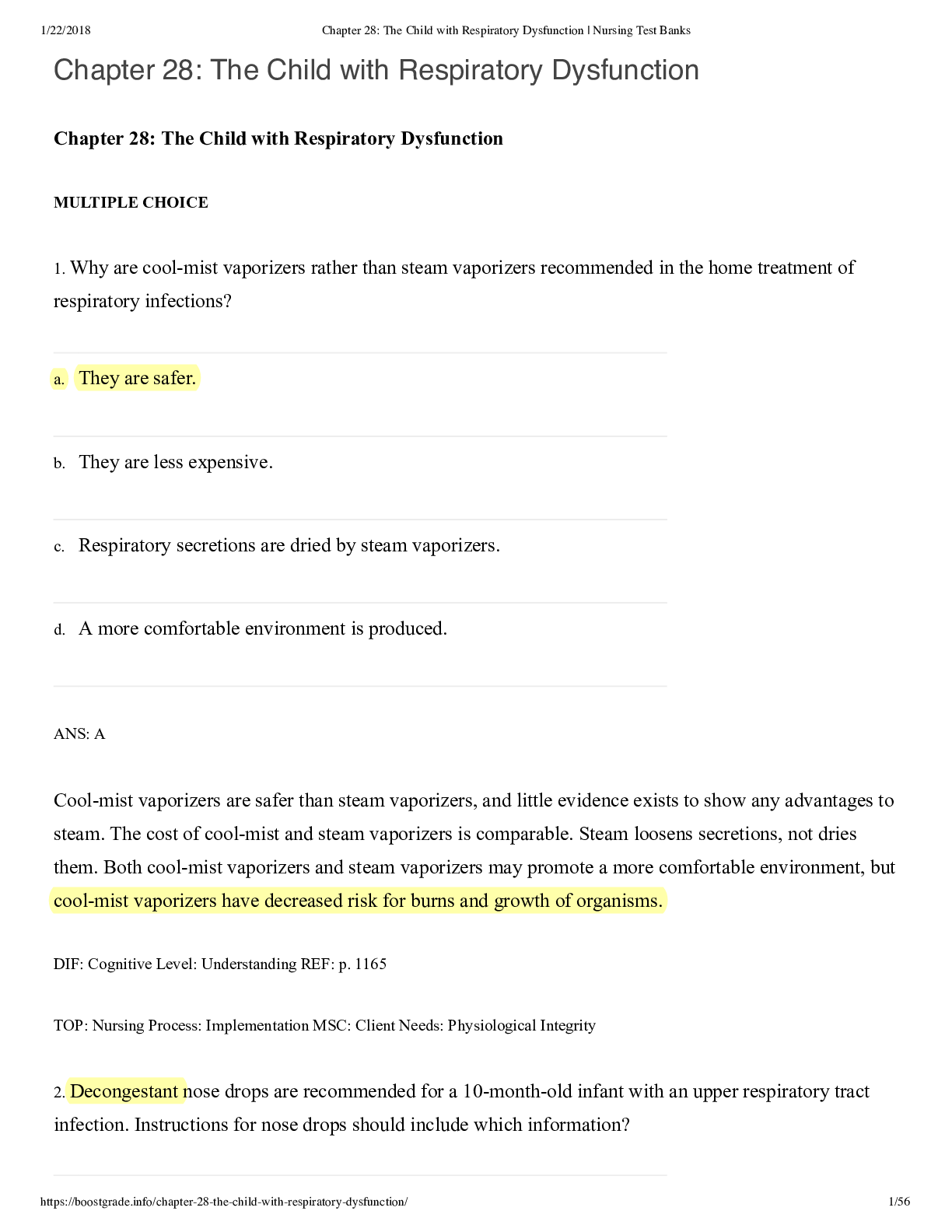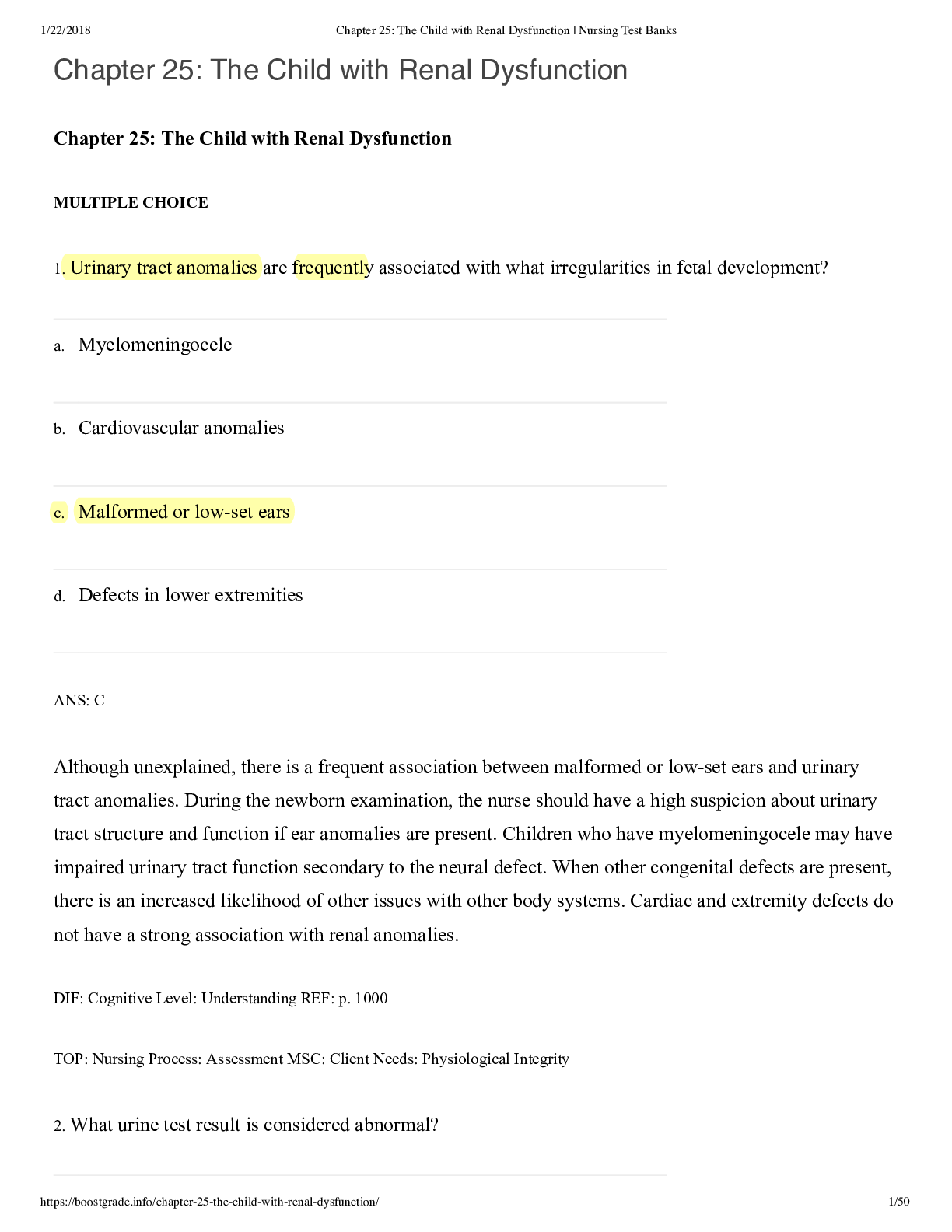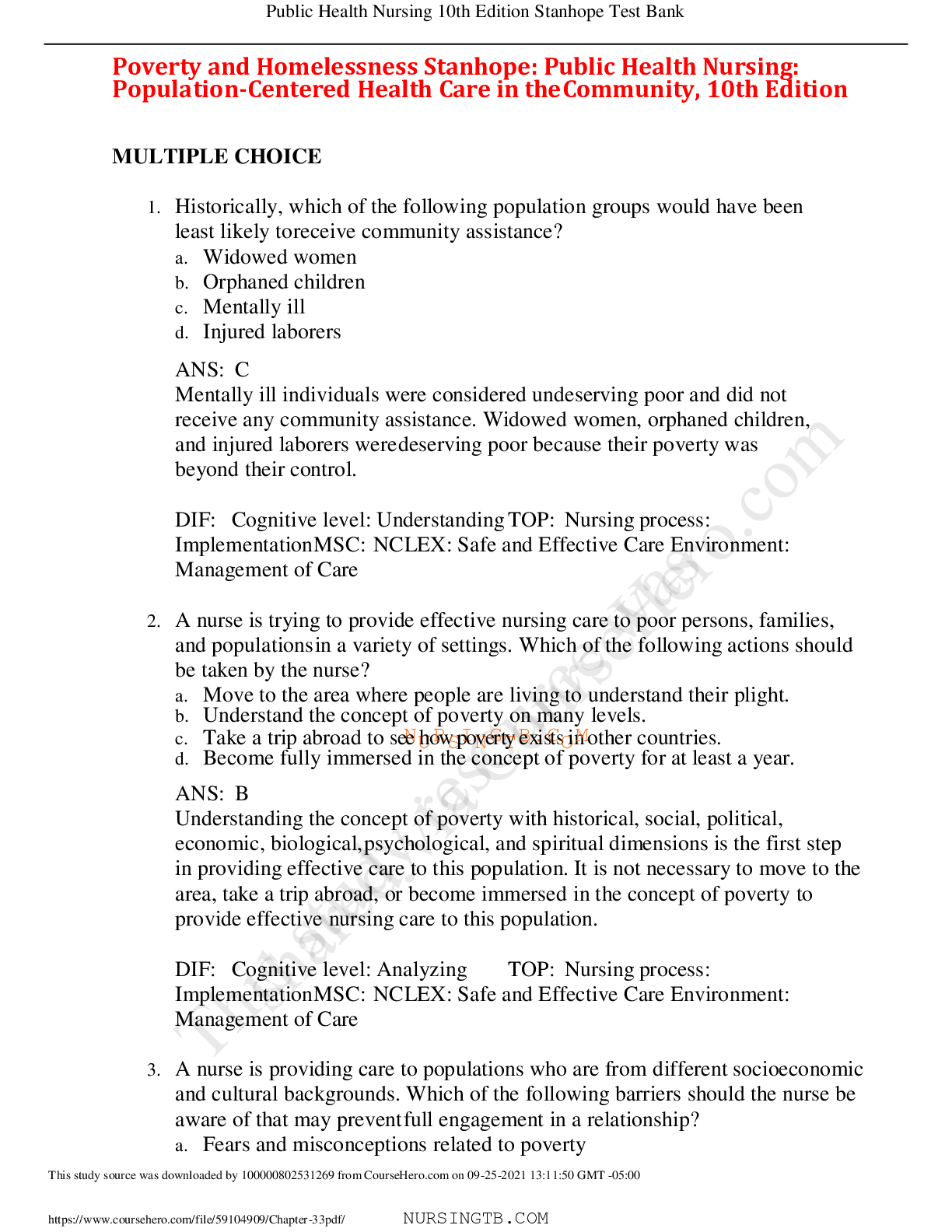*NURSING > TEST BANK > Stuvia-982834-exam-elaborations-nurs-4130-nurs-4130-medical-surgical-nursing-9th-edition-ignataviciu (All)
Stuvia-982834-exam-elaborations-nurs-4130-nurs-4130-medical-surgical-nursing-9th-edition-ignataviciu : NURSING NR292 : Chamberlain College of Nursing | Course Hero
Document Content and Description Below
Chapter 01: Overview of Professional Nursing Concepts for Medical- Surgical Nursing MULTIPLE CHOICE 1. A nurse wishes to provide client-centered care in all interactions. Which action by the nurse... best demonstrates this concept? a. Assesses for cultural influences affecting health care b. Ensures that all the clients basic needs are met c. Tells the client and family about all upcoming tests d. Thoroughly orients the client and family to the room ANS: A Competency in client-focused care is demonstrated when the nursefocuses on communication, culture, respect compassion, client education, and empowerment. By assessing the effect of the clients culture on health care, this nurse is practicing client-focused care. Providing for basic needs does not demonstrate this competence. Simply telling the client about all upcoming tests is not providing empowering education. Orienting the client andfamily to theroom is animportantsafetymeasure, butnotdirectlyrelatedtodemonstratingclient-centered care. DIF: Understanding/Comprehension REF: 3 KEY: Patient-centered care| culture MSC: Integrated Process: Caring NOT: Client Needs Category: Psychosocial Integrity 2. A nurse is caring for a postoperative client on the surgical unit. The clients blood pressure was 142/76 mm Hg 30 minutes ago, and now is 88/50 mm Hg. What action by the nurse isbest? a. Call the Rapid Response Team. b. Document and continue to monitor. c. Notify the primary care provider. d. Repeat blood pressure measurement in 15 minutes. ANS: A The purpose of the Rapid Response Team (RRT) is to intervene when clients are deteriorating before they suffereitherrespiratoryorcardiacarrest. Sincetheclienthasmanifestedasignificantchange, thenurseshould call the RRT. Changes in blood pressure, mental status, heart rate, and pain are particularly significant. Documentation is vital, but the nursemust do more than document. The primary care provider should be notified, but this is not the priority over calling the RRT. The clients blood pressure should be reassessed frequently, but the priority is getting the rapid care to theclient. DIF: Applying/Application REF: 3 KEY: Rapid Response Team (RRT)| medical emergencies MSC: Integrated Process: Communication and Documentation NOT: Client Needs Category: Physiological Integrity: Physiological Adaptation 3. A nurse is orienting a new client and family to the inpatient unit. What information does the nurse provide to help the client promote his or her own safety? a. Encourage the client and family to be active partners. b. Have the client monitor hand hygiene in caregivers. c. Offer the family the opportunity to stay with the client. d. Tell the client to always wear his or her armband. ANS: A Each action could be important for the client or family to perform. However, encouraging the client to be active in his or her health care as a partner is the most critical. The other actions are very limited in scope and do not provide the broad protection that being active and involveddoes. DIF: Understanding/Comprehension REF: 3 KEY: Patient safety lOMoAR cPSD| 60 78199 Stuvia.com - The Marketplace to Buy and Sell your Study Material Test Bank - Medical-Surgical Nursing: Concepts for Interprofessional Collaborative Care 9e 2 Downloaded by: rubricguru | [email protected] Distribution of this document is illegal MSC: Integrated Process: Teaching/Learning NOT: Client Needs Category: Safe and Effective Care Environment: Safety and Infection Control 4. A new nurse is working with a preceptor on an inpatientmedical-surgical unit. The preceptor advises the student that which is the priority when working as a professionalnurse? a. Attending to holistic client needs b. Ensuring client safety c. Not making medication errors d. Providing client-focused care ANS: B All actions are appropriate for the professional nurse. However, ensuring client safety is the priority. Up to 98,000 deaths result each year from errors in hospital care, according to the 2000 Institute of Medicine report. Many more clients have suffered injuries and less serious outcomes. Every nurse has the responsibility to guard the clients safety. DIF: Understanding/Comprehension REF: 2 KEY: Patient safety MSC: Integrated Process: Nursing Process: Intervention NOT: Client Needs Category: Safe and Effective Care Environment: Safety and Infection Control 5. A client is going to be admitted for a scheduled surgical procedure. Which action does the nurse explain is the most important thing the client can do to protect againsterrors? a. Bring a list of all medications and what they are for. b. Keep the doctors phone number by the telephone. c. Make sure all providers wash hands before entering the room. d. Write down the name of each caregiver who comes in the room. ANS: A Medication errors are the most common type of health care mistake. The Joint Commissions Speak Up campaign encourages clients to help ensure their safety. One recommendation is for clients to know all their medications and why they take them. This will help prevent medication errors. DIF: Applying/Application REF: 4 KEY: Speak Up campaign| patient safety MSC: Integrated Process: Teaching/Learning NOT: Client Needs Category: Safe and Effective Care Environment: Safety and Infection Control 6. Which action by the nurse working with a client best demonstrates respect for autonomy? a. Asks if the client has questions before signing a consent b. Gives the client accurate information when questioned c. Keeps the promises made to the client and family d. Treats the client fairly compared to other clients ANS: A Autonomy is self-determination. The client should make decisions regarding care. When the nurseobtainsa signature on the consent form, assessing if the client still has questions is vital, because without full information the client cannot practice autonomy. Giving accurate information is practicing with veracity. Keeping promises is upholding fidelity. Treating the client fairly is providing social justice. DIF: Applying/Application REF: 4 KEY: Autonomy| ethical principles MSC: Integrated Process: Caring NOT: Client Needs Category: Safe and Effective Care Environment: Management of Care 7. A student nurse asks the faculty to explain best practices when communicating with a person from the lesbian, gay, bisexual, transgender, andqueer/questioning (LGBTQ) community. Whatanswerbythe faculty is most accurate? a. Avoid embarrassing the client by asking questions. b. Dont make assumptions about their health needs. c. Most LGBTQ people do not want to share information. lOMoAR cPSD| 60 78199 Stuvia.com - The Marketplace to Buy and Sell your Study Material Test Bank - Medical-Surgical Nursing: Concepts for Interprofessional Collaborative Care 9e 3 Downloaded by: rubricguru | [email protected] Distribution of this document is illegal d. No differences exist in communicating with this population. ANS: B Manymembersofthe LGBTQcommunity have faceddiscrimination from health care providersandmaybe reluctant to seek health care. The nurse should never make assumptions about the needs of members of this population. Rather, respectful questionsareappropriate. If approached with sensitivity, the clientwith any health care need is more likely to answer honestly. DIF: Understanding/Comprehension REF: 4 KEY: LGBTQ| diversity MSC: Integrated Process: Teaching/Learning NOT: Client Needs Category: Psychosocial Integrity 8. A nurse is calling the on-call physician about a client who had a hysterectomy 2 days ago and has pain that is unrelieved by the prescribed narcotic pain medication. Which statement is part of the SBAR format for communication? a. A: I would like you to order a different pain medication. b. B: This client has allergies to morphine and codeine. c. R: Dr. Smith doesnt like nonsteroidal anti-inflammatory meds. d. S: This client had a vaginal hysterectomy 2 days ago. ANS: B SBAR is a recommended form of communication, and the acronym stands for Situation, Background, Assessment, and Recommendation. Appropriatebackgroundinformationincludesallergies to medicationsthe on-callphysicianmightorder. Situationdescribeswhat is happening rightnow thatmustbecommunicated; the clients surgery 2 days ago would be considered background. Assessment would include an analysis of the clients problem; asking for a different pain medication is a recommendation. Recommendation is a statement of what is needed or what outcome is desired; this information about the surgeons preference might be better placed in background. DIF: Applying/ApplicationREF: 5 KEY: SBAR| communication MSC: Integrated Process: Communication and [Show More]
Last updated: 1 year ago
Preview 1 out of 862 pages
Instant download

Buy this document to get the full access instantly
Instant Download Access after purchase
Add to cartInstant download
Reviews( 0 )
Document information
Connected school, study & course
About the document
Uploaded On
Feb 04, 2023
Number of pages
862
Written in
Additional information
This document has been written for:
Uploaded
Feb 04, 2023
Downloads
0
Views
72


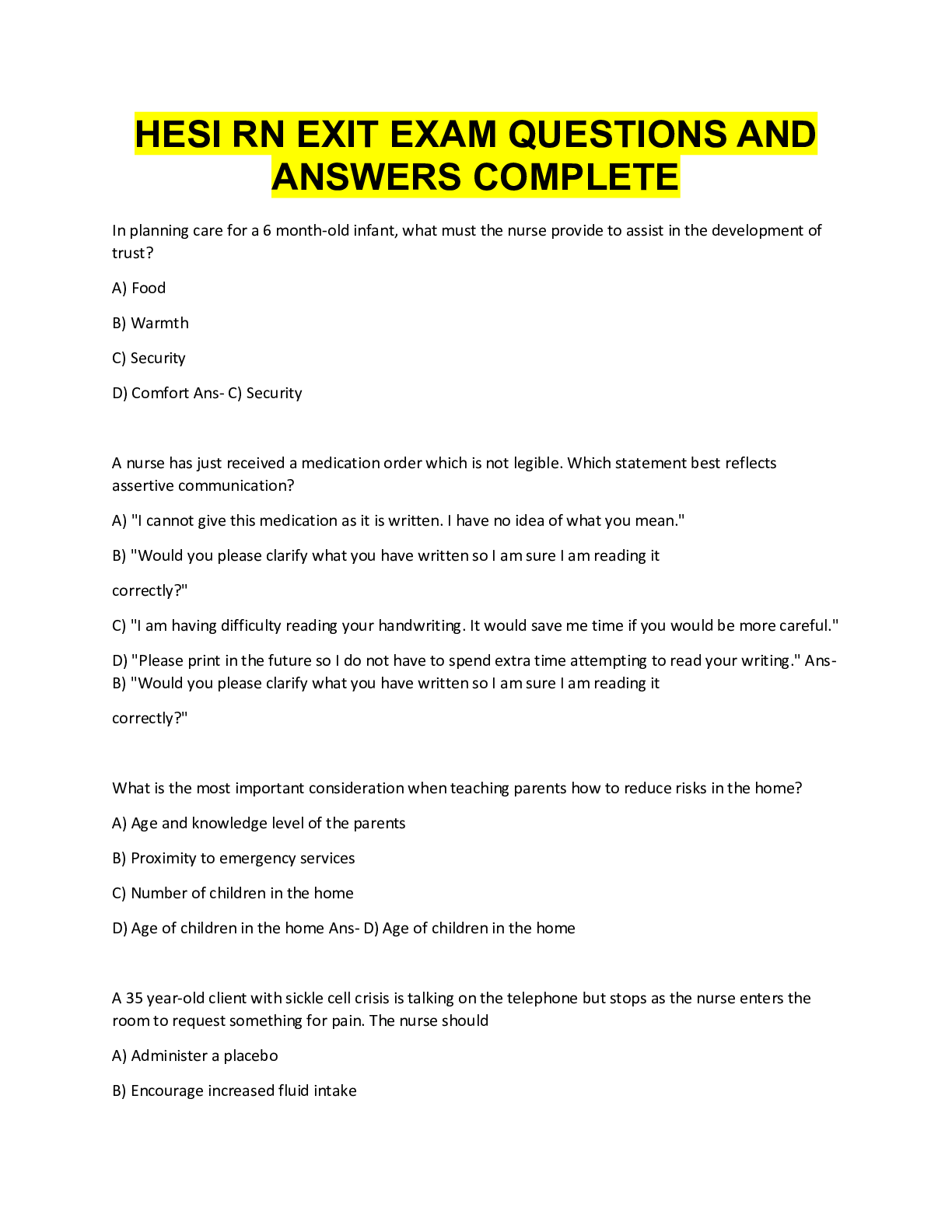
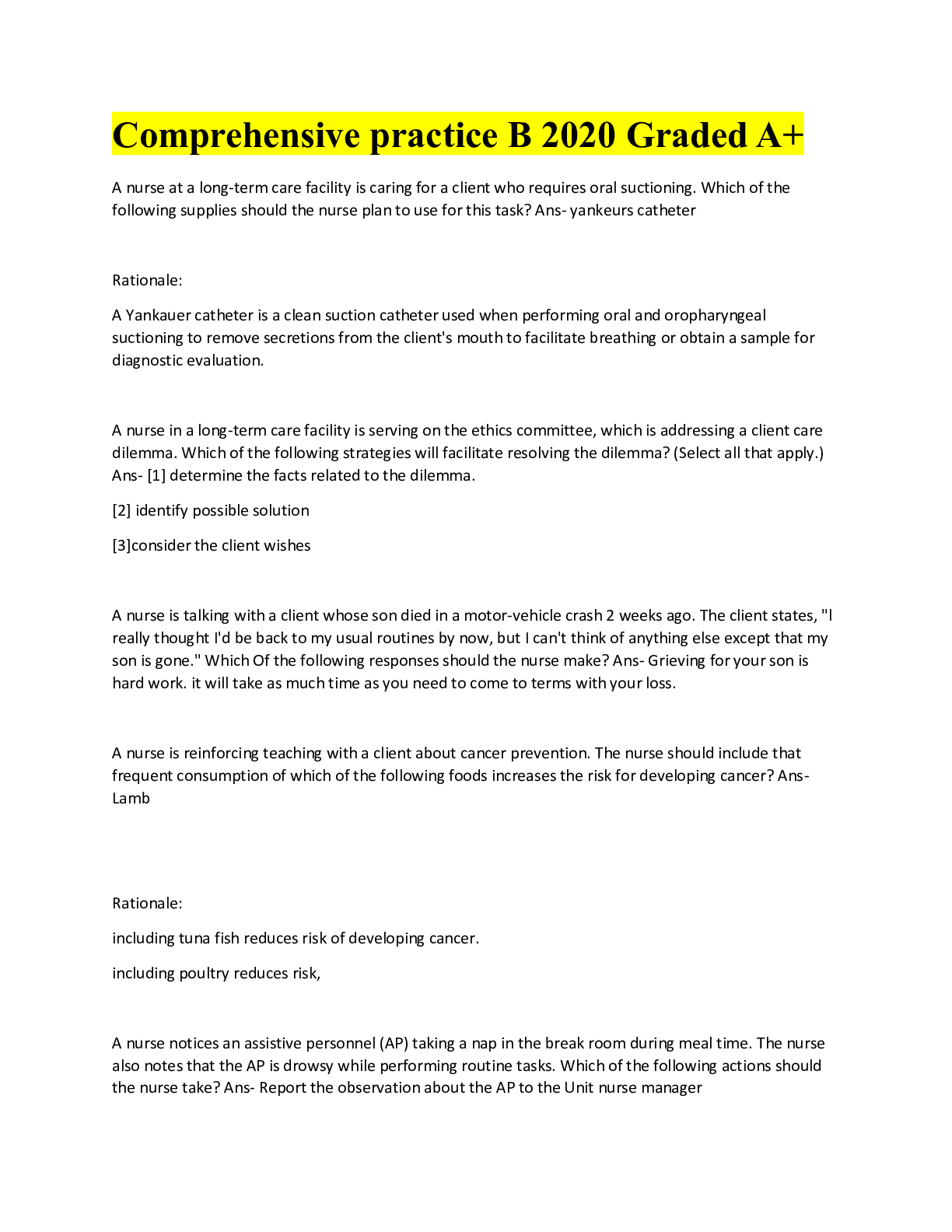
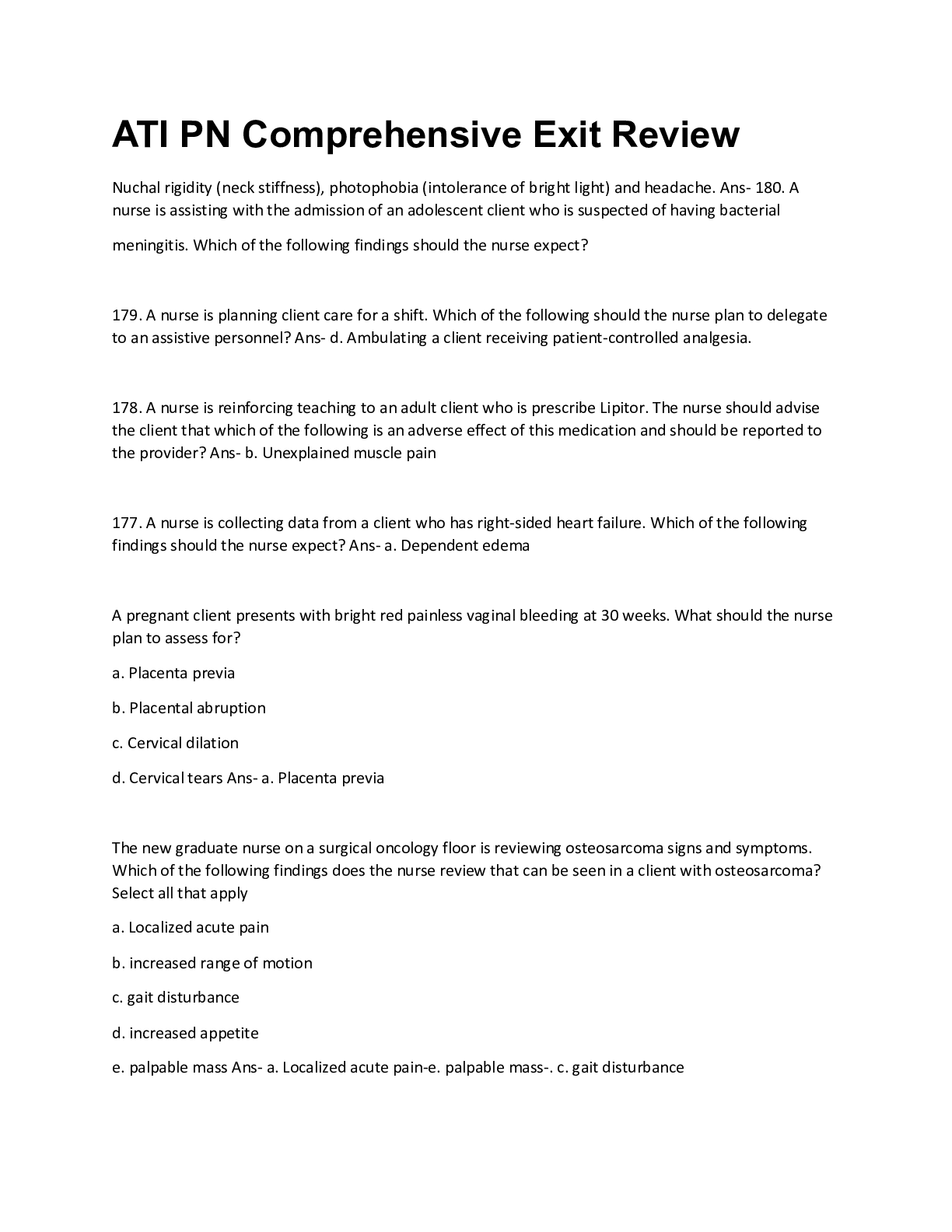

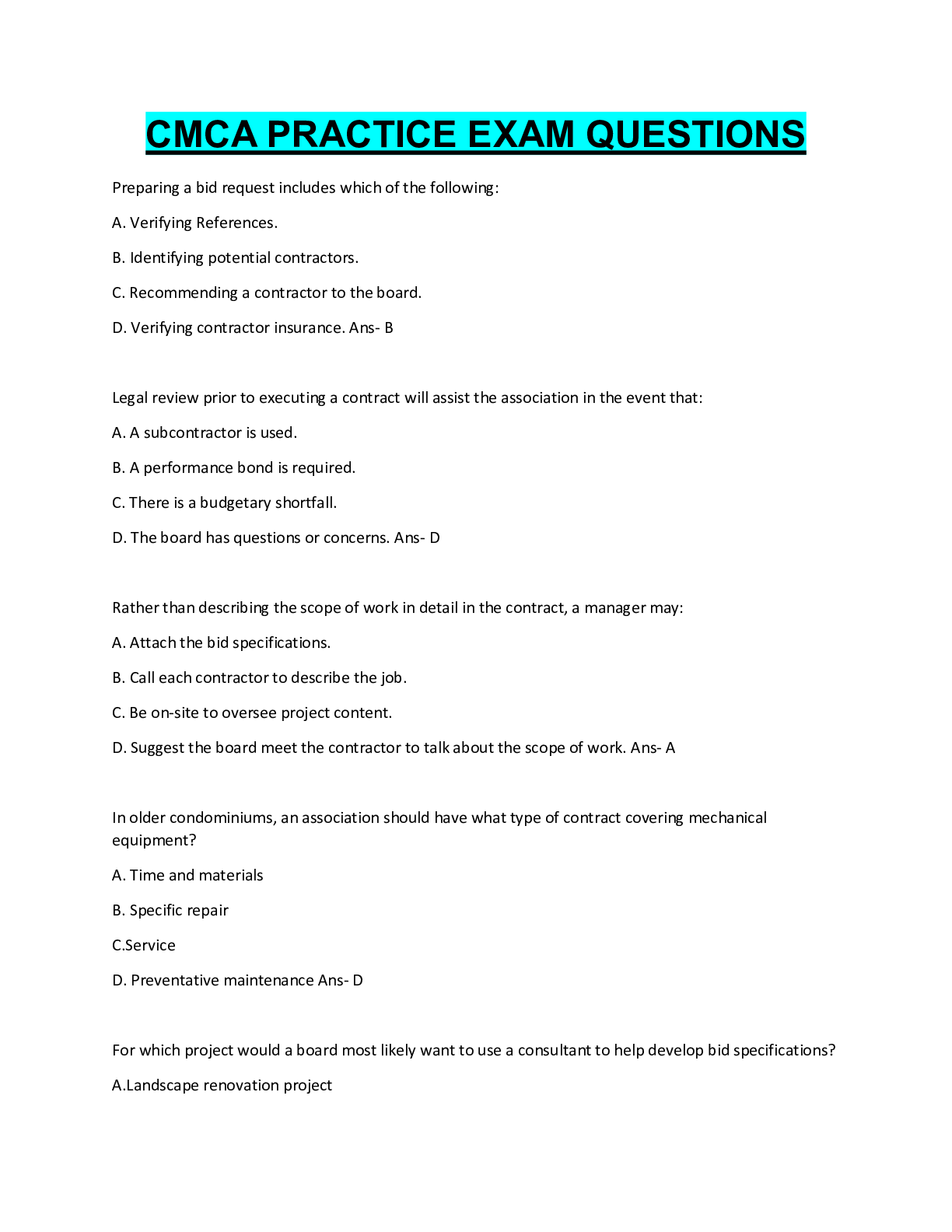

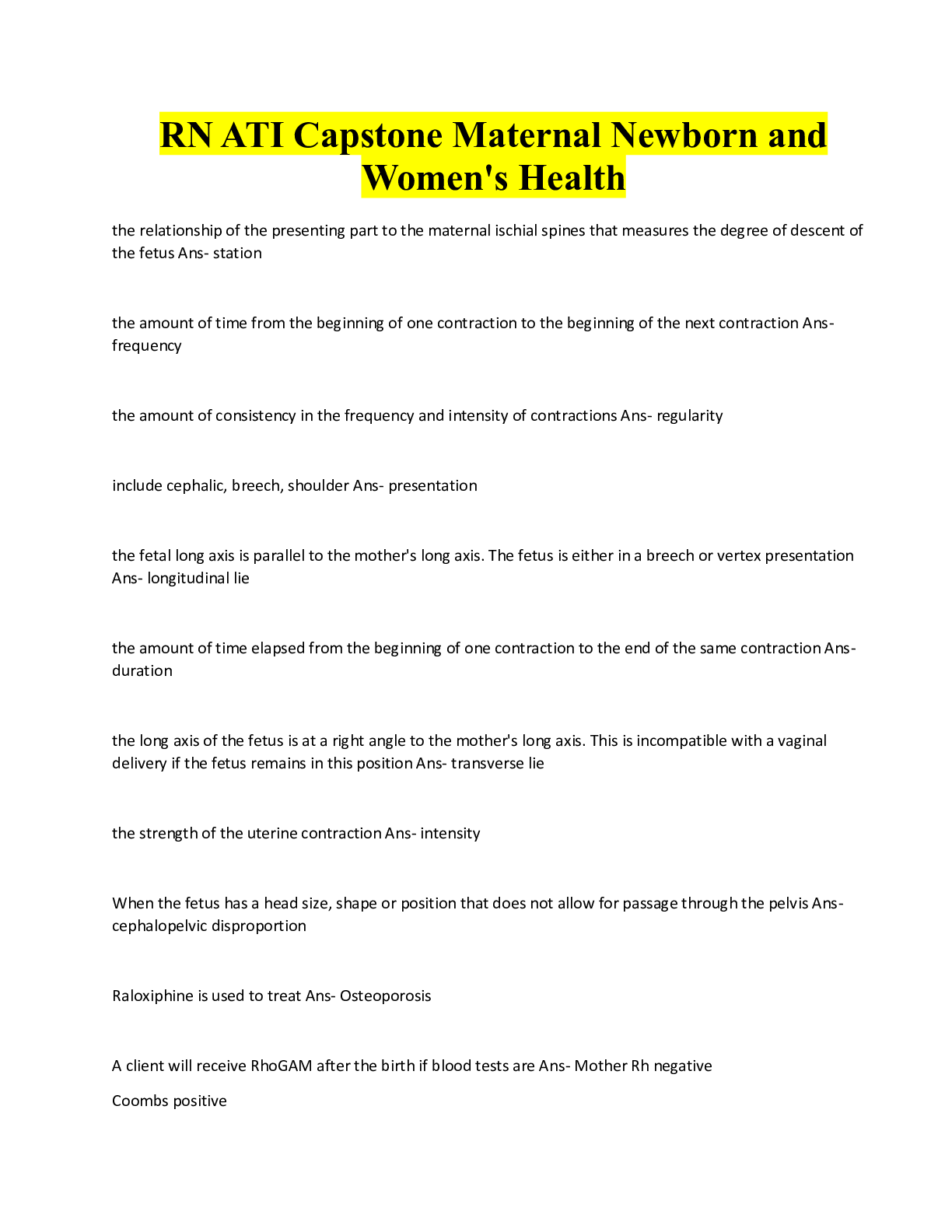
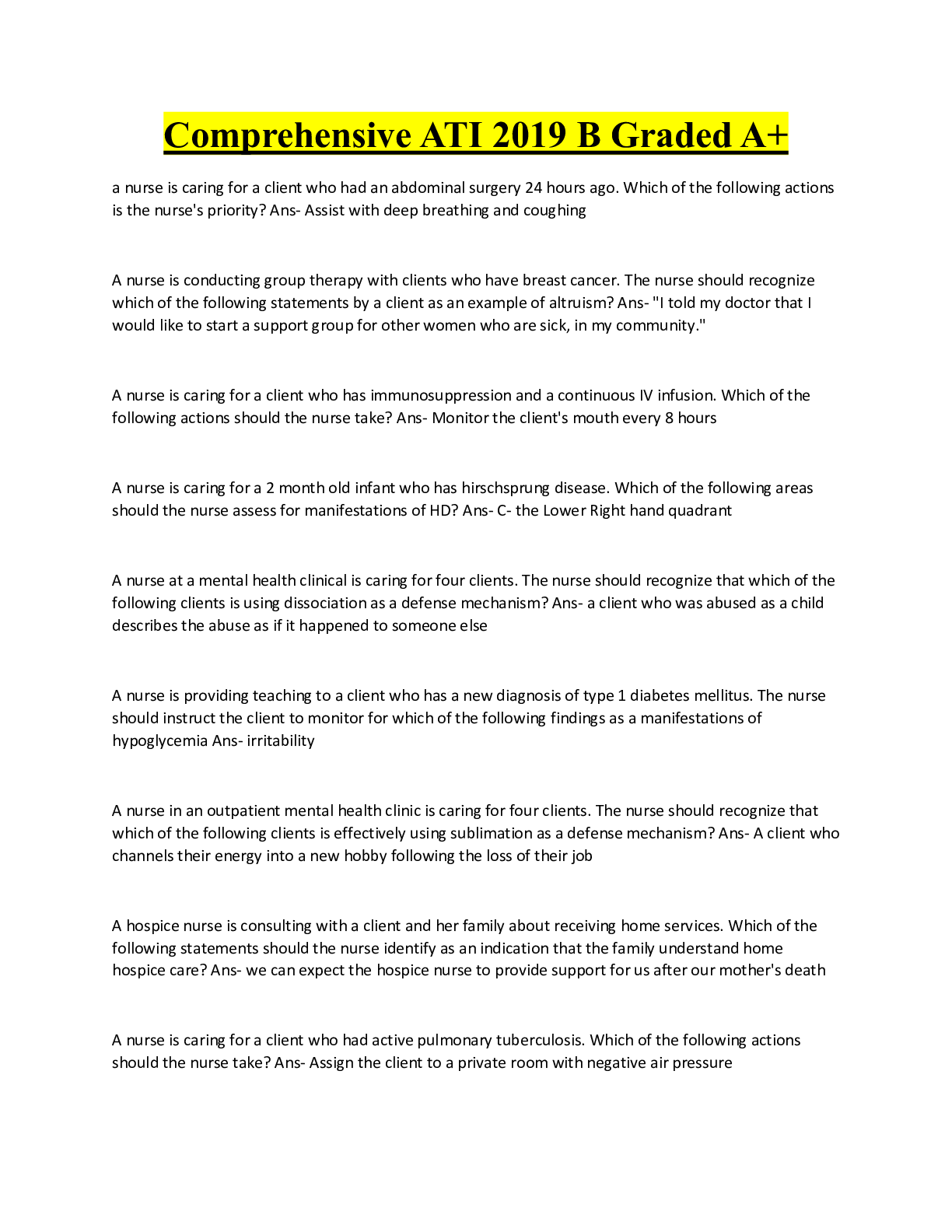

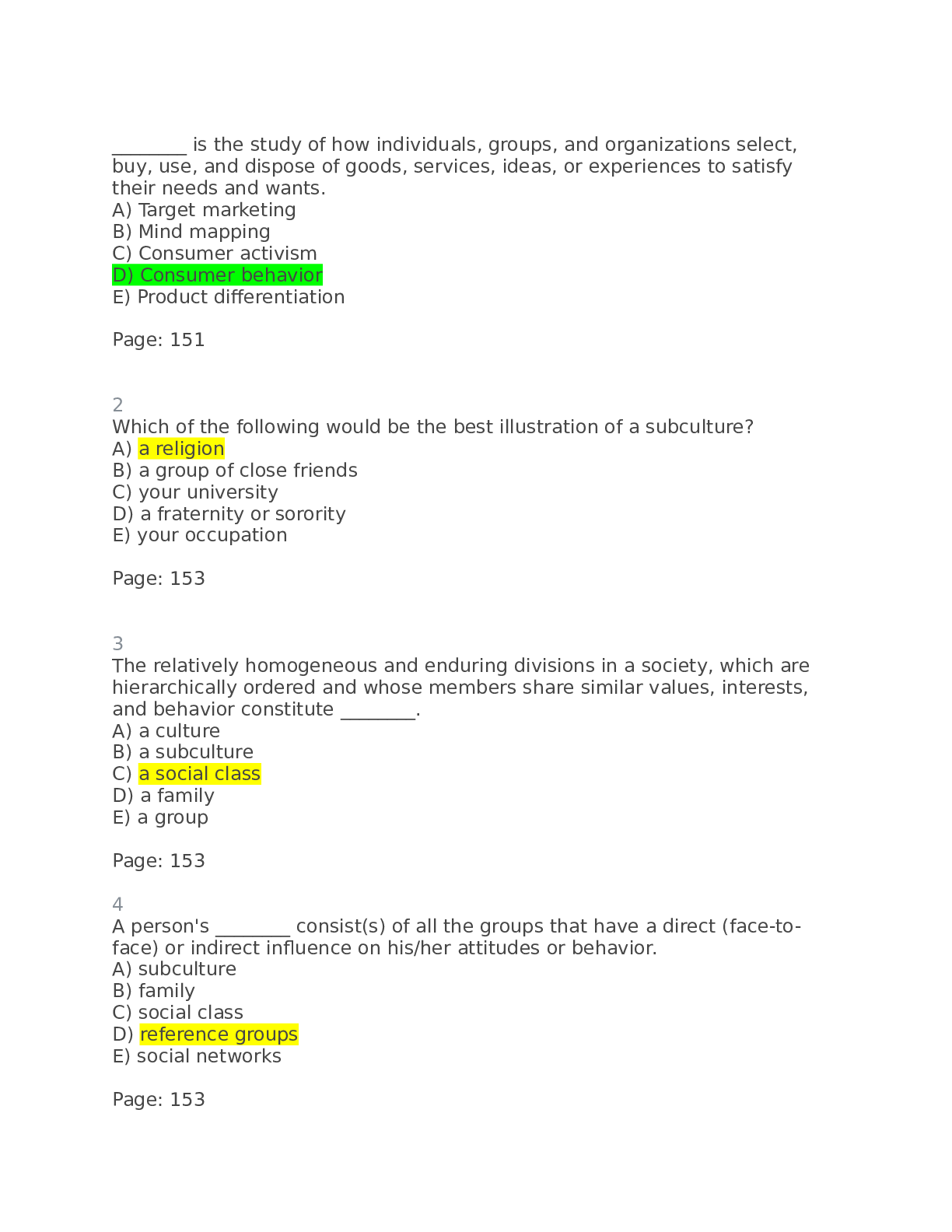
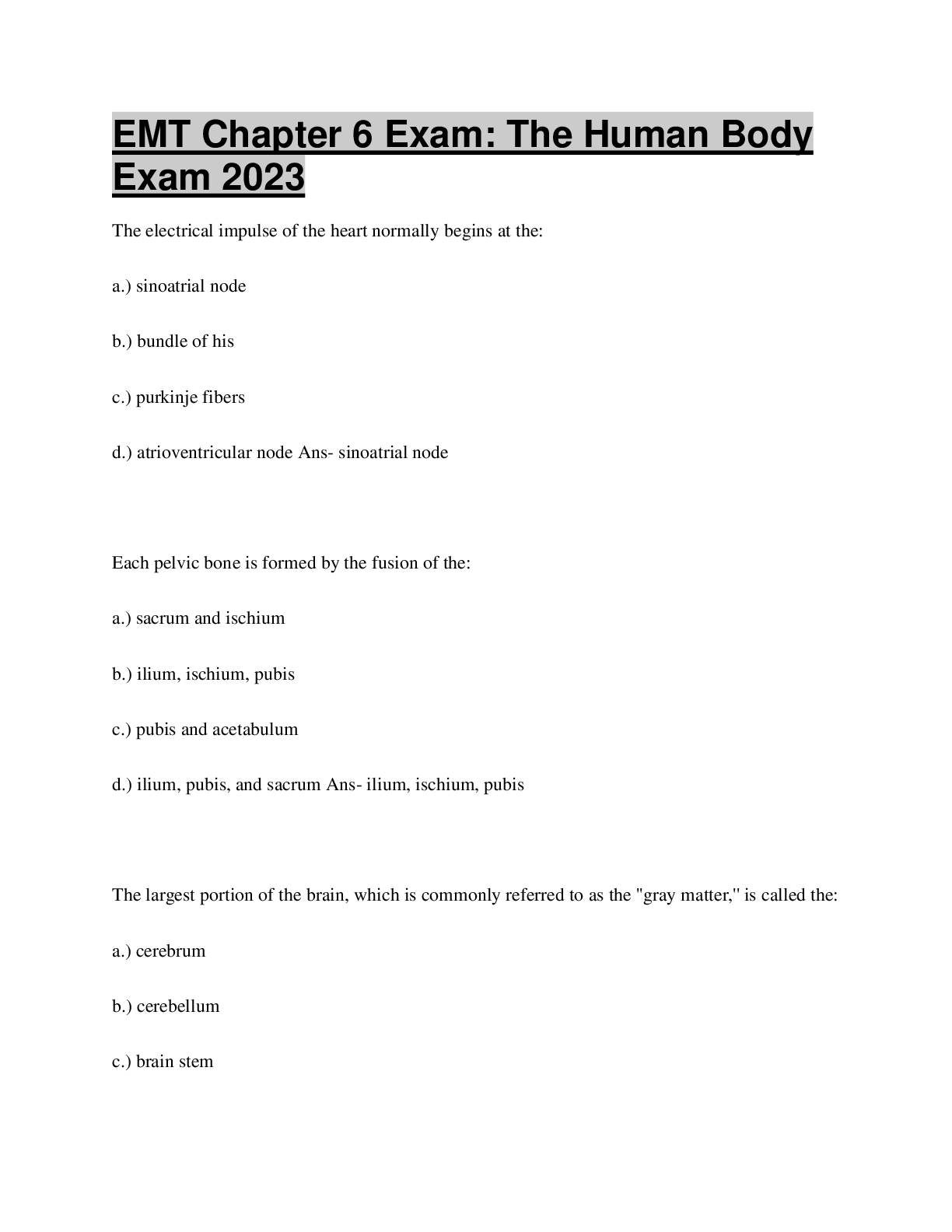
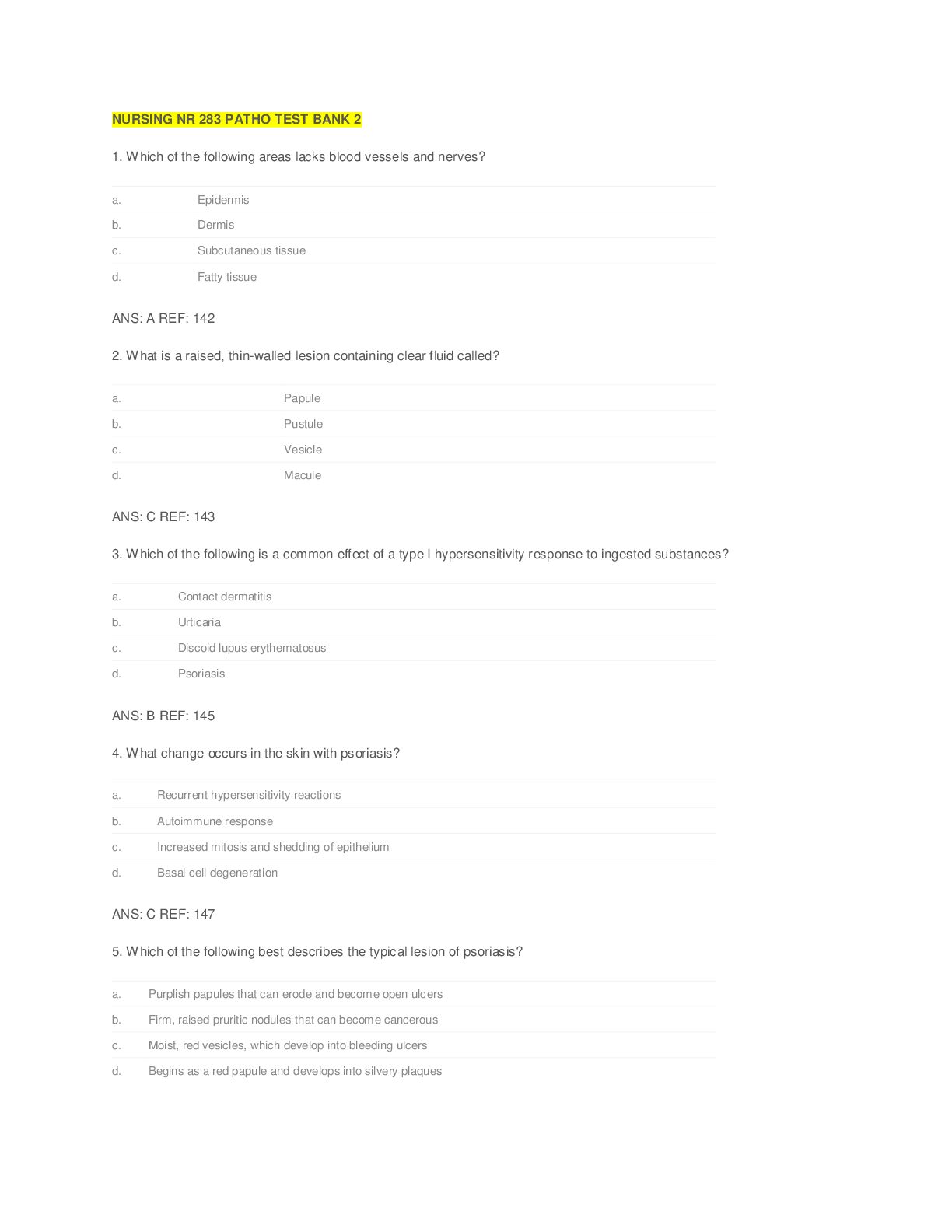
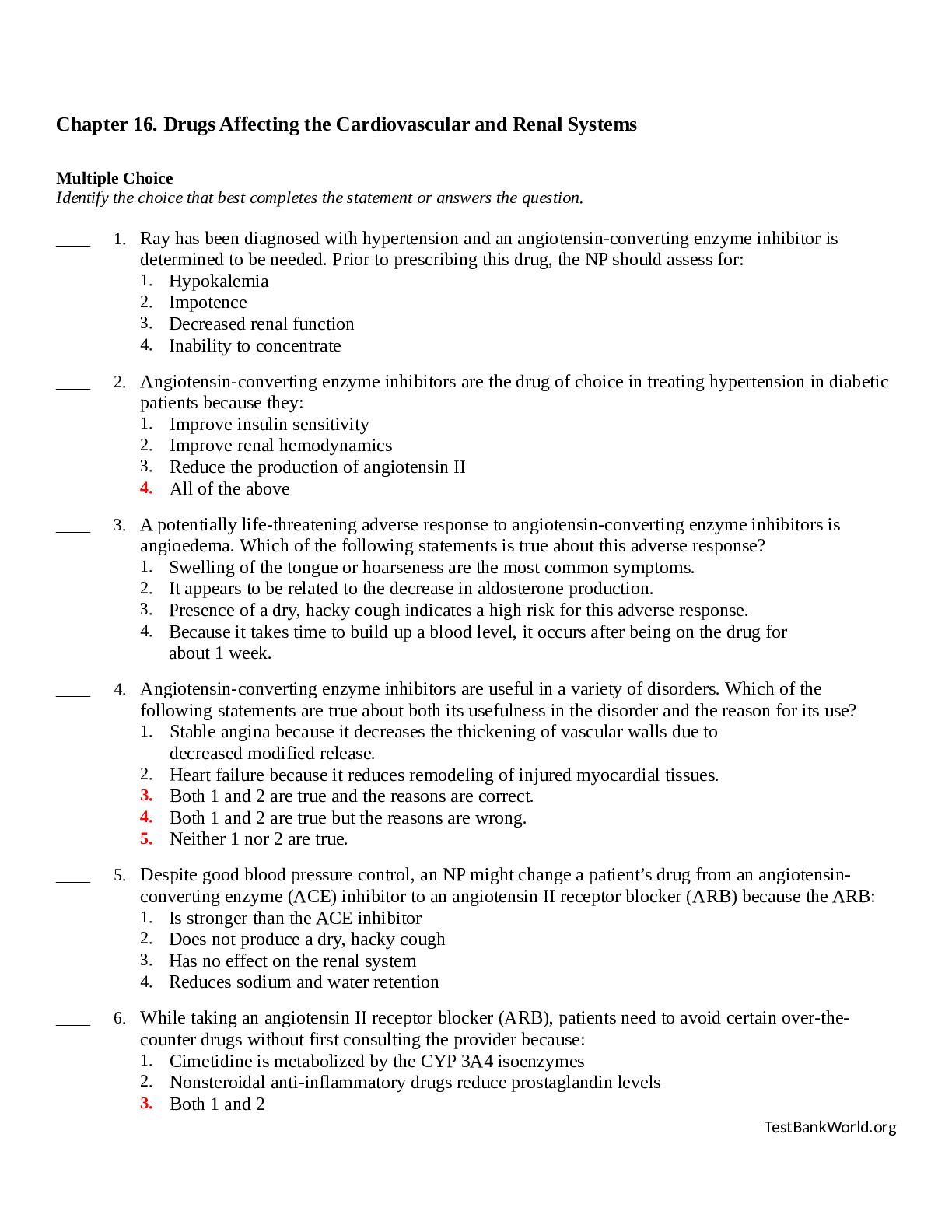
.png)
